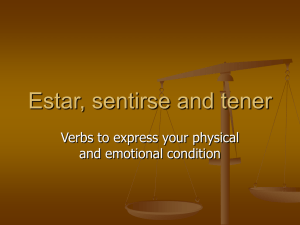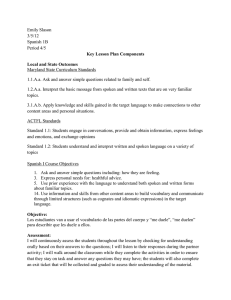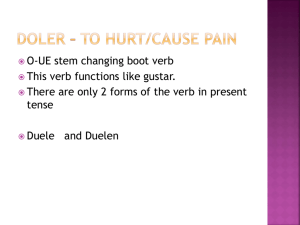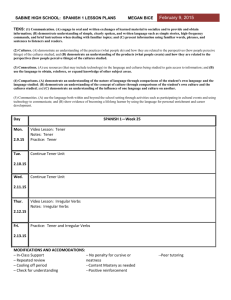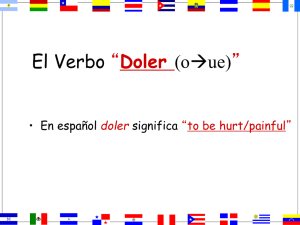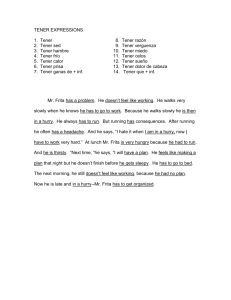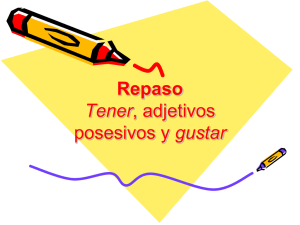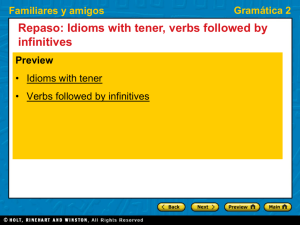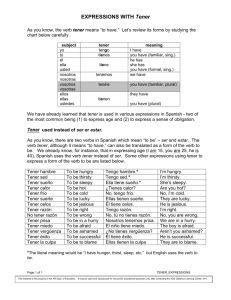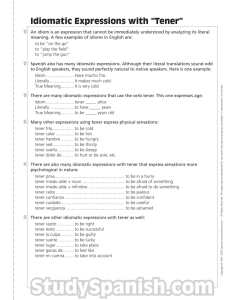Sentirse (eie)=to feel
advertisement
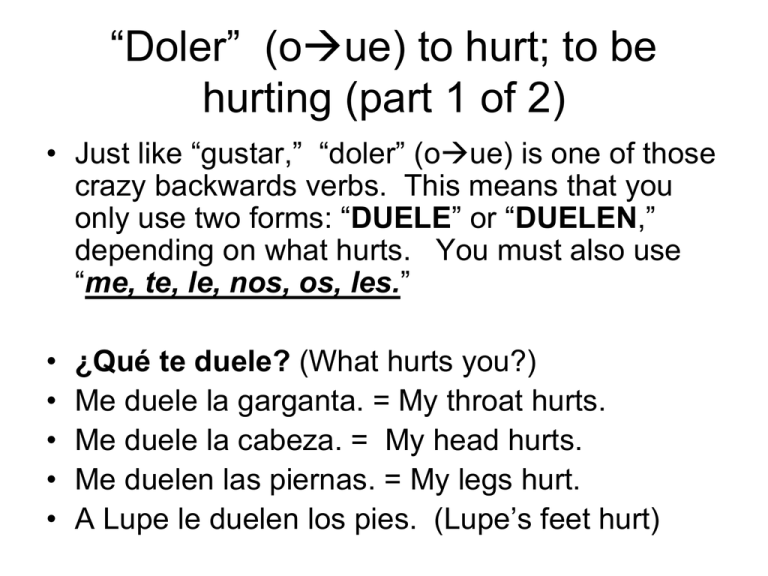
“Doler” (oue) to hurt; to be hurting (part 1 of 2) • Just like “gustar,” “doler” (oue) is one of those crazy backwards verbs. This means that you only use two forms: “DUELE” or “DUELEN,” depending on what hurts. You must also use “me, te, le, nos, os, les.” • • • • • ¿Qué te duele? (What hurts you?) Me duele la garganta. = My throat hurts. Me duele la cabeza. = My head hurts. Me duelen las piernas. = My legs hurt. A Lupe le duelen los pies. (Lupe’s feet hurt) Doler” (oue) to hurt; to be hurting (part 2 of 2) • • • • By the way: (el dolor = the pain) (el dólar = dollar $) (el dolor de cabeza = the headache) Sentirse (eie) = to feel • me siento nos sentimos • te sientes os sentís • se siente se sienten • ¿Te sientes bien? • Sí, me siento bien. Tener = to have • Tener = to have • tengo tenemos • tienes tenéis • tiene tienen • Form of tener + frío = to be cold • “ calor = hot • “ miedo = afraid • “ sueño = to be sleepy “ hambre = hungry Ejemplos: • Tengo frío = I’m cold • Tenemos miedo = We are afraid. • Ud. Tiene sueño = You are sleepy • ¿Tienes hambre? = Are you hungry? • Lola y Rico tienen calor. = Lola p. 251 #27 Estar = to be Sentirse (ei)=to feel Estoy Estás Está Estamos Estáis están Tener + frío = cold calor = hot me siento, miedo = te sientes , afraid se siente, sueño = nos sentimos sleepy Sed = thirst os sentís Hambre = se sienten hungry Form of Negative Informal Commands • • • • • • • • • • • • • **Remember: affirmative commands tú form, take off “s” easy eight (p. 252) reflexives get attached- lávate ***First, you have to think if the verb you want to use is one of the “EASY EIGHT.” If it is one of the “EASY EIGHT”, simply use that form: Decir di (say, tell) Tener ten (have) Venir ven (come) Poner pon (put, place, set) Ir ve (go) Ser sé (be) Hacer haz (do) Salir sal (leave) ***If the verb is NOT one of the “EASY EIGHT” , use the “Drop the “S” Rule.” : Take the “tú” form of the present tense and drop the “s”. Yes, it’s that easy! Speak Spanish! = ¡Habla español! Run, Forrest, Run! = ¡Corre, Forest, corre! Play Soccer! = ¡Juega al fútbol! Summary: Steps to an affirmative TÚ command: 1. Determine if the verb is on the “Easy Eight” list. If it is, just use the “Easy Eight” form. 2. If the verb is NOT on the “Easy Eight” list, take the tú form and drop the “s.” SECRET HINT: You could also just use the “ÉL, ELLA, USTED” form. It’s the same as the “tú” form minus the “s.” Tricky-tricky • • • • Negative Irregulars: 1. dar no des (don’t give) 2. ir no vayas (don’t go) 3. ser no seas (don’t be) • For most other “-ar” verbs, drop the “-o” from the yo form and add “-es” • fumo no fumes- don’t smoke • For most other “-er”, “-ir” verbs, drop “o” from yo form and add “-as” • duermo no duermas (don’t sleep) • Reflexives go before verb no te laves
